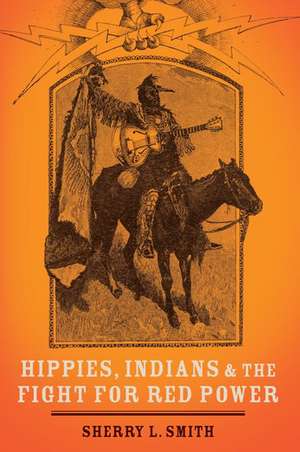Hippies, Indians, and the Fight for Red Power
Autor Sherry L. Smithen Limba Engleză Paperback – 23 oct 2014
| Toate formatele și edițiile | Preț | Express |
|---|---|---|
| Paperback (1) | 256.55 lei 31-37 zile | |
| Oxford University Press – 23 oct 2014 | 256.55 lei 31-37 zile | |
| Hardback (1) | 341.86 lei 31-37 zile | |
| Oxford University Press – 24 mai 2012 | 341.86 lei 31-37 zile |
Preț: 256.55 lei
Preț vechi: 297.75 lei
-14% Nou
Puncte Express: 385
Preț estimativ în valută:
49.10€ • 53.00$ • 41.17£
49.10€ • 53.00$ • 41.17£
Carte tipărită la comandă
Livrare economică 08-14 aprilie
Preluare comenzi: 021 569.72.76
Specificații
ISBN-13: 9780190217853
ISBN-10: 0190217855
Pagini: 282
Ilustrații: 15 halftones
Dimensiuni: 155 x 231 x 18 mm
Greutate: 0.41 kg
Editura: Oxford University Press
Colecția OUP USA
Locul publicării:New York, United States
ISBN-10: 0190217855
Pagini: 282
Ilustrații: 15 halftones
Dimensiuni: 155 x 231 x 18 mm
Greutate: 0.41 kg
Editura: Oxford University Press
Colecția OUP USA
Locul publicării:New York, United States
Recenzii
In this remarkably insightful work, Sherry L. Smith brings to light a series of cross-cultural encounters during the Red Power era that until now have not been carefully parsed. ... Her persuasive analysis reveals example after example of meaningful cooperation and sincere mutual support. ... It is a bold and important retelling that should shape our discussions for years to come.
Smith's book is...a model of cross-racial negotiation. She sees her task as correcting the record on the makeup of Red Power politics without diminishing the leadership of 'the original American 'long hairs' or the costs borne by their communities. She...judiciously trac[es] the false starts and the achievements of co-operation.
Smith must be commended for opening a new door on the counterculture-Indian relationship. Smith's well written text substantially advances our understanding of the multiethnic nature of Native American activism in the 1960s and 1970s, and it both reveals and redeems the imaginings of Indianness by sixties hippies as important to that cause.
Elegantly written and thoroughly documented Smith does an excellent job of shedding light not only on the complicated relations between Indians and non-Indians but also on the nuances within Indian America, particularly among various Red Power movements, more established organizations like the National Congress of American Indians, and reservation-based tribal governments.
An outstanding book.... Smith has written one of the very best histories of 'Red Power'. ... Her account of how Indian activists fought for greater sovereignty and control over their lands and their collective lives by attracting outside support and forging alliances with nonIndians is a moving and thought-provoking tale. ... Her method in analyzing the Red Power movement is innovative.... An exemplary account of a major sixties-era social change movement that can serve as a conceptual model.
A convincing, concise, and readable introduction to a topic with which many readers may be unfamiliar.
If ever there was a story difficult to get right, it's the turbulent confluence of hippies and American Indians in the 1960s and 70s. Sherry Smith gets it right.
With penetrating analysis, Sherry Smith argues eloquently that the 1960s and 1970s were the defining moment in modern political history for America and American Indians struggling for justice. This book defines this pivotal time; it contextualizes nationwide political activism by putting an odd couple - Indians and hippies together - on the center stage of making history. Absolutely brilliant!
Sherry Smith has done a masterful job of sorting out the braided cultural strains which tangled and interpenetrated during the cultural and political revolutions of the Sixties. I was present at a number of these events, knew many of the players, and am amazed at the way she has clarified 'the fog of war,' which is how history recounted appears to participants. Her book covers an unacknowledged aspect of Native people's struggle for justice and the confusing, often ignorant manner in which counter-culture hipsters, liberals, and well-meaning do-gooders tried to 'help' them. Through it all, 'White' cultural assumptions loom as large as a rude and noisy guest at a prayer breakfast. It's eye-opening, ground-breaking work and deserves to be read.
Without ever losing sight of the larger tragedy of American Indian history, Sherry Smith writes deftly and often wryly of the 1960s and 1970s when the counterculture and the New Left discovered Indians, and Indians discovered the political possibilities that alienated young white Americans presented. The results were sometimes comic, sometimes painful, occasionally touching, but always revealing of the changing valence of Indian peoples and cultures in American society and American politics. This is an original and absorbing book.
Smith's book is...a model of cross-racial negotiation. She sees her task as correcting the record on the makeup of Red Power politics without diminishing the leadership of 'the original American 'long hairs' or the costs borne by their communities. She...judiciously trac[es] the false starts and the achievements of co-operation.
Smith must be commended for opening a new door on the counterculture-Indian relationship. Smith's well written text substantially advances our understanding of the multiethnic nature of Native American activism in the 1960s and 1970s, and it both reveals and redeems the imaginings of Indianness by sixties hippies as important to that cause.
Elegantly written and thoroughly documented Smith does an excellent job of shedding light not only on the complicated relations between Indians and non-Indians but also on the nuances within Indian America, particularly among various Red Power movements, more established organizations like the National Congress of American Indians, and reservation-based tribal governments.
An outstanding book.... Smith has written one of the very best histories of 'Red Power'. ... Her account of how Indian activists fought for greater sovereignty and control over their lands and their collective lives by attracting outside support and forging alliances with nonIndians is a moving and thought-provoking tale. ... Her method in analyzing the Red Power movement is innovative.... An exemplary account of a major sixties-era social change movement that can serve as a conceptual model.
A convincing, concise, and readable introduction to a topic with which many readers may be unfamiliar.
If ever there was a story difficult to get right, it's the turbulent confluence of hippies and American Indians in the 1960s and 70s. Sherry Smith gets it right.
With penetrating analysis, Sherry Smith argues eloquently that the 1960s and 1970s were the defining moment in modern political history for America and American Indians struggling for justice. This book defines this pivotal time; it contextualizes nationwide political activism by putting an odd couple - Indians and hippies together - on the center stage of making history. Absolutely brilliant!
Sherry Smith has done a masterful job of sorting out the braided cultural strains which tangled and interpenetrated during the cultural and political revolutions of the Sixties. I was present at a number of these events, knew many of the players, and am amazed at the way she has clarified 'the fog of war,' which is how history recounted appears to participants. Her book covers an unacknowledged aspect of Native people's struggle for justice and the confusing, often ignorant manner in which counter-culture hipsters, liberals, and well-meaning do-gooders tried to 'help' them. Through it all, 'White' cultural assumptions loom as large as a rude and noisy guest at a prayer breakfast. It's eye-opening, ground-breaking work and deserves to be read.
Without ever losing sight of the larger tragedy of American Indian history, Sherry Smith writes deftly and often wryly of the 1960s and 1970s when the counterculture and the New Left discovered Indians, and Indians discovered the political possibilities that alienated young white Americans presented. The results were sometimes comic, sometimes painful, occasionally touching, but always revealing of the changing valence of Indian peoples and cultures in American society and American politics. This is an original and absorbing book.
Notă biografică
Sherry L. Smith is University Distinguished Professor of History and Associate Director of the Clements Center for Southwest Studies at Southern Methodist University. She is the author of Reimagining Indians: Native Americans through Anglo Eyes, 1880-1940 (OUP, 2000); The View from Officers' Row: Army Perceptions of Western Indians; and Sagebrush Soldier: William Earl Smith's View of the Sioux War of 1876.














